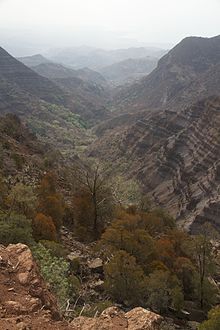Tadjourah Region
Tadjourah Region
(Afar) Rakaakay Tagórri (Somali) Gobolka Tajoora | |
|---|---|
Tadjourah | |
| Area | |
| • Total | 7,100 km2 (2,700 sq mi) |
| Population (2022) | |
| • Total | 115,149[1] |
| ISO 3166 code | DJ-TA |
The Tadjourah Region
History
The boundaries of the present-day Djibouti nation state were established during the Scramble for Africa. The first French establishment in the Horn of Africa, and in 1884 they sign a treaty with the Afar.[2][3] The poet Arthur Rimbaud became a trader, and lived in Tadjoura from 1885 to 1886. He was the owner of a particular ship carrying weapons to be sold to the King of Shoa, cousin of the father of future Ethiopian Emperor Haile Selassie. In 1883 the French Somaliland (French: Côte française des Somalis) was officially founded.
Overview

The region is the largest of the country's 'six' (one of which is sometimes termed a city instead of a region, the country's eponymous capital with the bulk of the country's population,
The capital of the Tadjourah Region is
Due to its many whitewashed buildings and structures, Tadjourah is known as the White City. Most people in the wider region are involved in marine commerce, including a large number of fishermen. The region has sandy beaches, tourism and trade. It exports salts from deposits around
According to the 2009 Census, the local population consists of 89,567 individuals, 48,402 of whom are nomads.
Day Forest

The region has the roughly circular Day Forest National Park in many, often precipitous valleys of the
Climate
Elevations play a major factor in temperature, with the escarpments and plateaus on average 11 °C (52 °F) cooler, day or night. The climate of the coastal strip is influenced by warm ocean waters, keeping the closest parts free from extremes highs and providing occasional rainfall. The overnight lows in the highlands - the western half of the region - drop to about 50–59 °F (10–15 °C).
The annual mean statistics for some Tadjoura Region centres is shown below:
| Town | Min. Temp | Max. Temp | Rainfall |
|---|---|---|---|
| Tadjoura | 22.2 °C (72.0 °F) | 41.7 °C (107.1 °F) | 186 mm (7.3 in) |
| Adailou | 13.7 °C (56.7 °F) | 34.4 °C (93.9 °F) | 322 mm (12.7 in) |
| Randa | 13.7 °C (56.7 °F) | 34.7 °C (94.5 °F) | 325 mm (12.8 in) |
| Airolaf | 9.3 °C (48.7 °F) | 31.9 °C (89.4 °F) | 431 mm (17.0 in) |
| Dorra | 19.0 °C (66.2 °F) | 39.5 °C (103.1 °F) | 161 mm (6.3 in) |
| Guirrari | 15.5 °C (59.9 °F) | 35.9 °C (96.6 °F) | 265 mm (10.4 in) |
| Itki | 11.3 °C (52.3 °F) | 32.3 °C (90.1 °F) | 418 mm (16.5 in) |
Towns

| Town names |
|---|
Tadjourah
|
| Randa |
`Assa Gaila
|
| Adailou |
| Sagallo |
| Airolaf |
| Dorra |
| Balho |
| Guirrari |
| Bankouale |
| Mouddo |
| Debne |
| Ambabbo |
| Adoyla |
| Itki |
| Malaho |
| Bouyya |
| Karabti San |
References
- "Djibouti". World Factbook. Central Intelligence Agency. 2007-09-06. Archived from the originalon June 13, 2007. Retrieved 2007-09-18.
- ^ "Djibouti Population". presidence.dj. Retrieved 2 February 2020.
- ^ "Tracer des frontières à Djibouti". djibouti.frontafrique.org. Retrieved 2020-10-23.
- ^ "Tracer des frontières à Djibouti". djibouti.frontafrique.org. Retrieved 2020-10-23.
- ISBN 9781741049886. Retrieved 3 November 2012.
